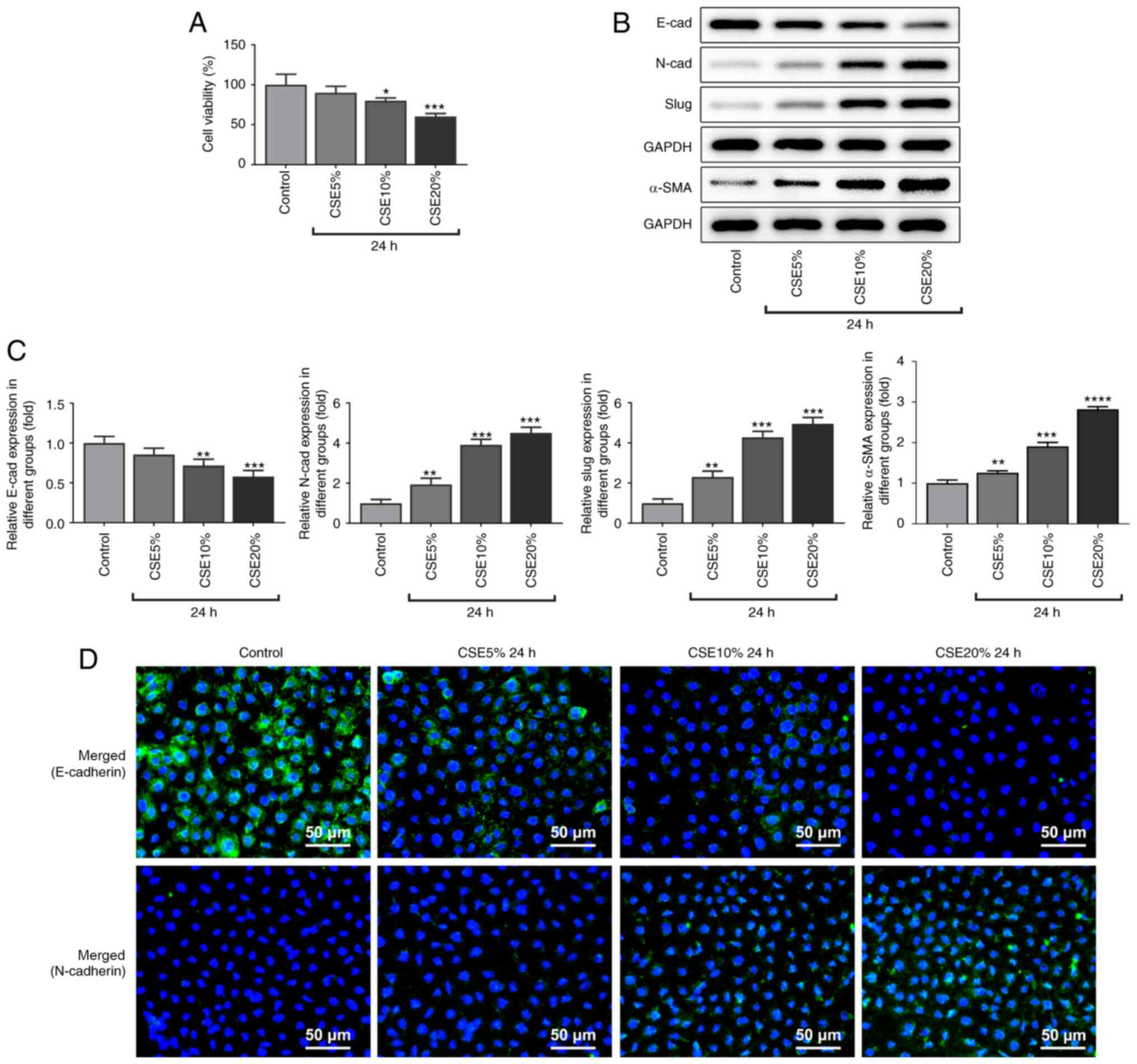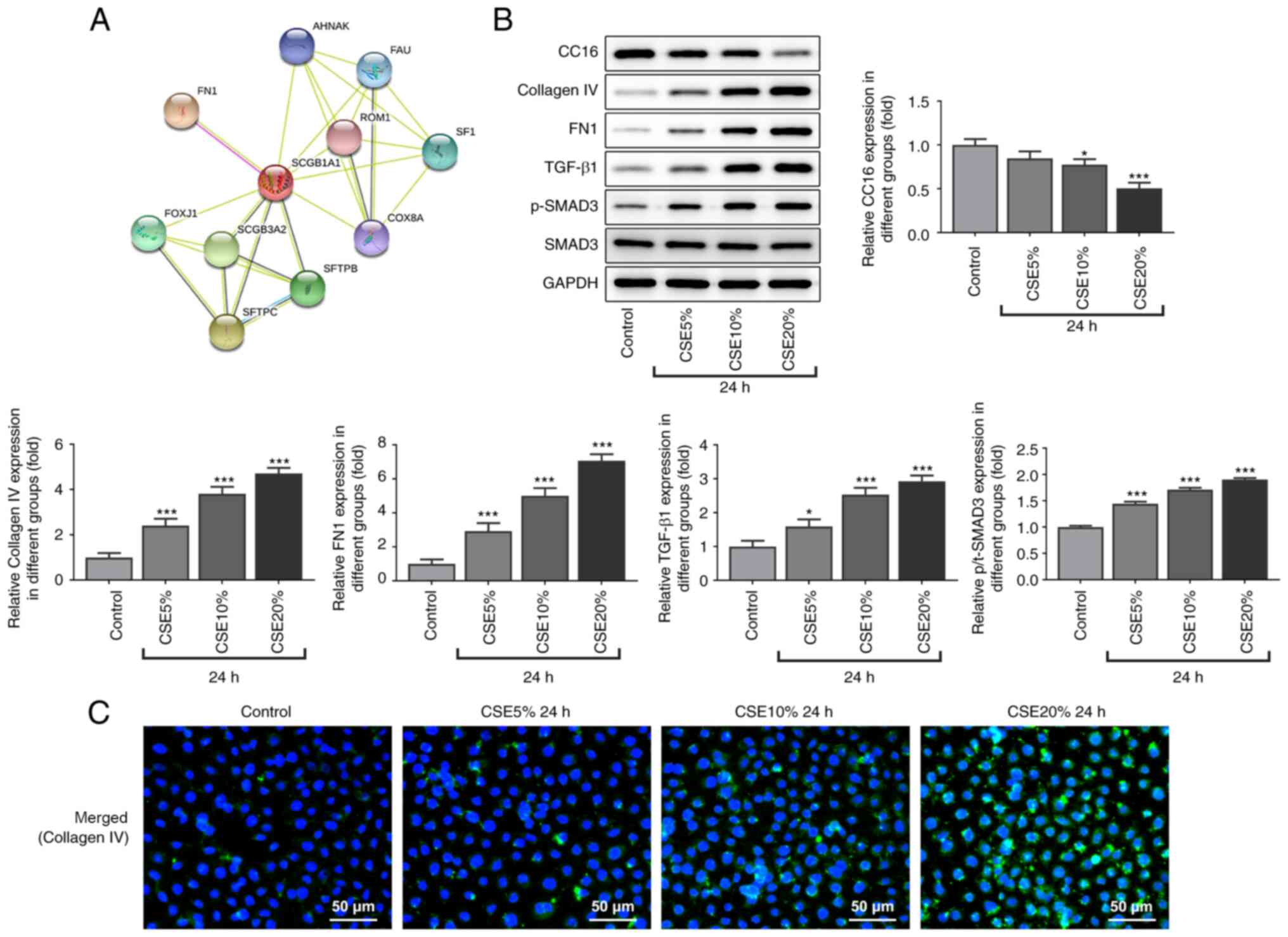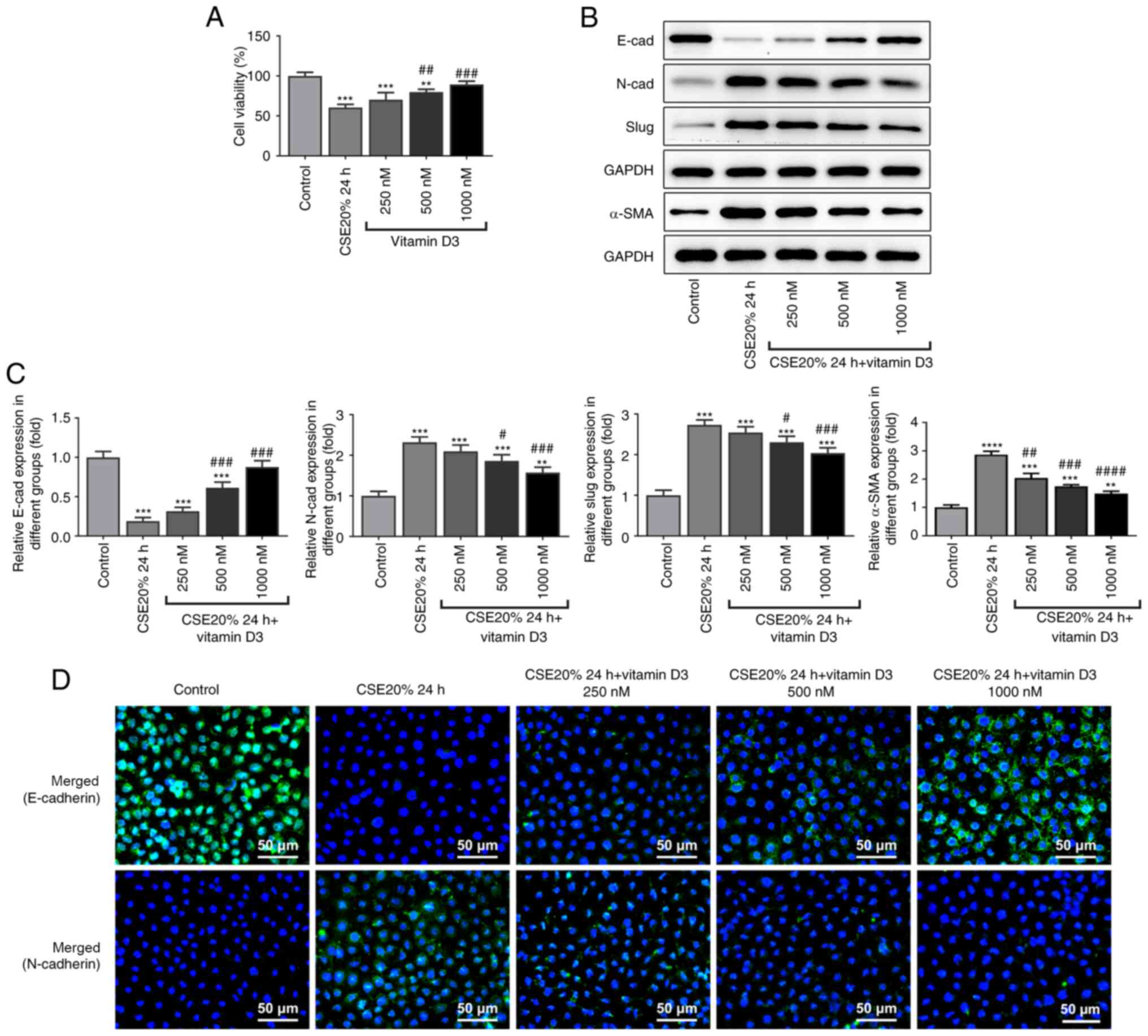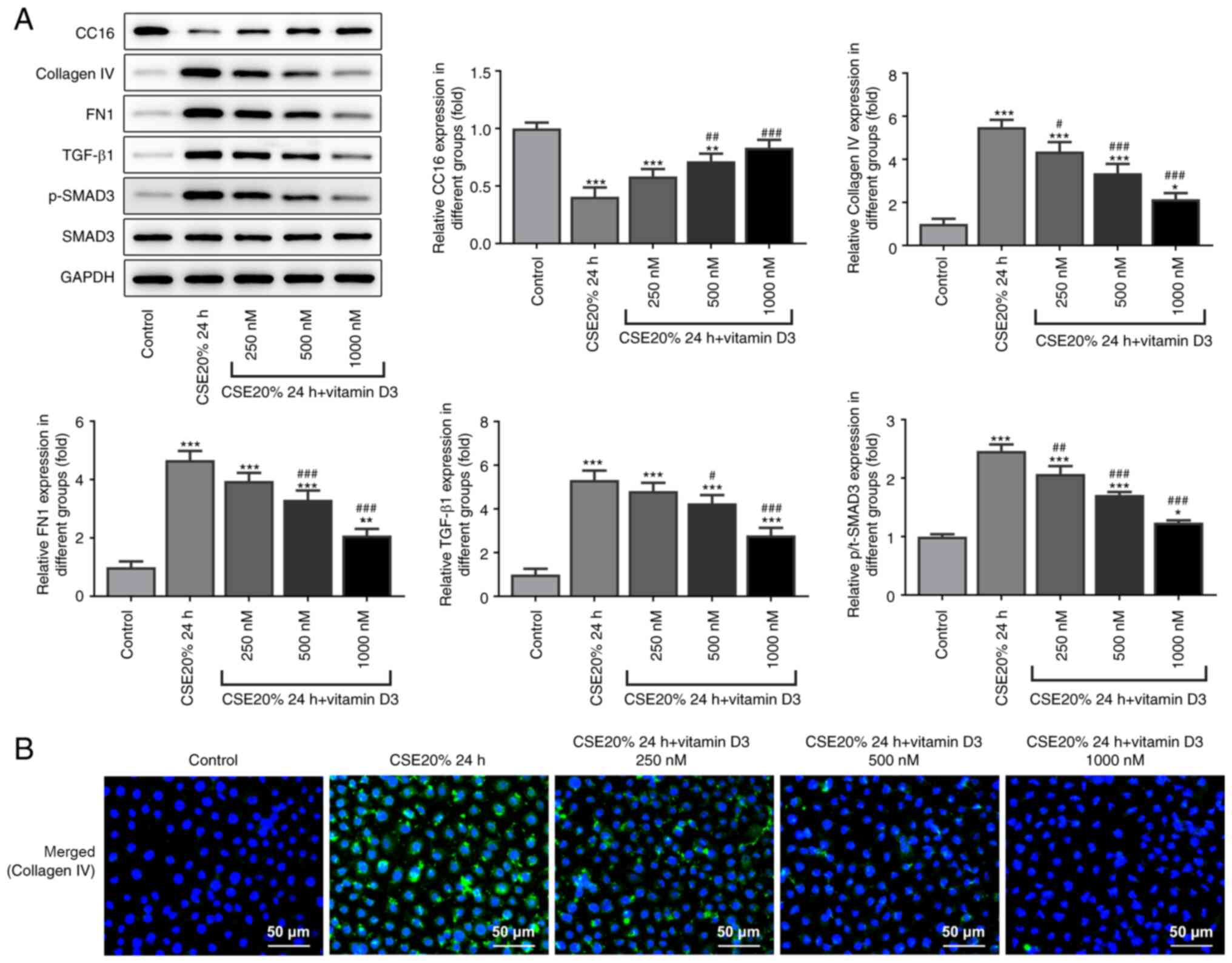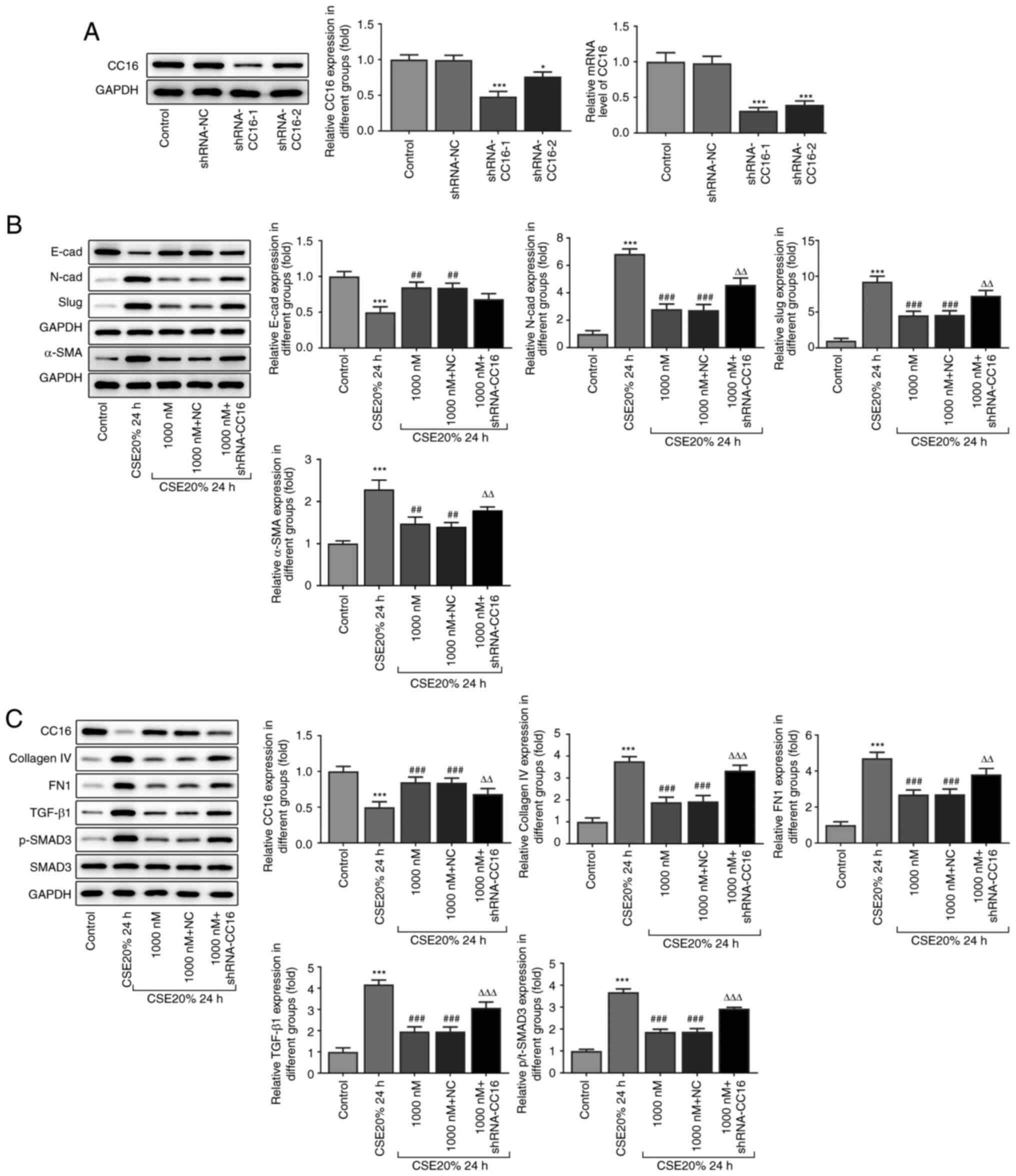|
1
|
Lozano R, Naghavi M, Foreman K, Lim S,
Shibuya K, Aboyans V, Abraham J, Adair T, Aggarwal R, Ahn SY, et
al: Global and regional mortality from 235 causes of death for 20
age groups in 1990 and 2010: A systematic analysis for the global
burden of disease study 2010. Lancet. 380:2095–2128.
2012.PubMed/NCBI View Article : Google Scholar
|
|
2
|
Pauwels RA and Rabe KF: Burden and
clinical features of chronic obstructive pulmonary disease (COPD).
Lancet. 364:613–620. 2004.PubMed/NCBI View Article : Google Scholar
|
|
3
|
Churg A, Brauer M, del Carmen Avila-Casado
M, Fortoul TI and Wright JL: Chronic exposure to high levels of
particulate air pollution and small airway remodeling. Environ
Health Perspect. 111:714–718. 2003.PubMed/NCBI View
Article : Google Scholar
|
|
4
|
Brakema EA, Tabyshova A, Kasteleyn MJ,
Molendijk E, van der Kleij RMJJ, van Boven JFM, Emilov B,
Akmatalieva M, Mademilov M, Numans ME, et al: High COPD prevalence
at high altitude: Does household air pollution play a role? Eur
Respir J. 53(1801193)2018.PubMed/NCBI View Article : Google Scholar
|
|
5
|
Hall R, Hall IP and Sayers I: Genetic risk
factors for the development of pulmonary disease identified by
genome-wide association. Respirology. 24:204–214. 2019.PubMed/NCBI View Article : Google Scholar
|
|
6
|
Barrera C, Rocchi S, Degano B, Soumagne T,
Laurent L, Bellanger AP, Laplante JJ, Millon L, Dalphin JC and
Reboux G: Microbial exposure to dairy farmers' dwellings and COPD
occurrence. Int J Environ Health Res. 29:387–399. 2019.PubMed/NCBI View Article : Google Scholar
|
|
7
|
Vasques F, Camporota L and Barrett NA:
Nonantibiotic pharmacological treatment of severe chronic
obstructive pulmonary disease exacerbations. Semin Respir Crit Care
Med. 41:842–850. 2020.PubMed/NCBI View Article : Google Scholar
|
|
8
|
Kim V and Criner GJ: Chronic bronchitis
and chronic obstructive pulmonary disease. Am J Respir Crit Care
Med. 187:228–237. 2013.PubMed/NCBI View Article : Google Scholar
|
|
9
|
Matera MG, Calzetta L, Rogliani P, Cesario
A and Cazzola M: New treatments for COPD in the elderly. Curr Pharm
Des. 20:5968–5982. 2014.PubMed/NCBI View Article : Google Scholar
|
|
10
|
Eapen MS, Sharma P, Thompson IE, Lu W,
Myers S, Hansbro PM and Sohal SS: Heparin-binding epidermal growth
factor (HB-EGF) drives EMT in patients with COPD: Implications for
disease pathogenesis and novel therapies. Lab Invest. 99:150–157.
2019.PubMed/NCBI View Article : Google Scholar
|
|
11
|
Barnes PJ: Small airway fibrosis in COPD.
Int J Biochem Cell Biol. 116(105598)2019.PubMed/NCBI View Article : Google Scholar
|
|
12
|
Clapéron A, Mergey M, Ho-Bouldoires TH,
Vignjevic D, Wendum D, Chrétien Y, Merabtene F, Frazao A, Paradis
V, Housset C, et al: EGF/EGFR axis contributes to the progression
of cholangiocarcinoma through the induction of an
epithelial-mesenchymal transition. J Hepatol. 61:325–332.
2014.PubMed/NCBI View Article : Google Scholar
|
|
13
|
Han YT, Chen XH, Gao H, Ye JL and Wang CB:
Physcion inhibits the metastatic potential of human colorectal
cancer SW620 cells in vitro by suppressing the transcription factor
SOX2. Acta Pharmacol Sin. 37:264–275. 2016.PubMed/NCBI View Article : Google Scholar
|
|
14
|
Kannan A, Krishnan A, Ali M, Subramaniam
S, Halagowder D and Sivasithamparam ND: Caveolin-1 promotes gastric
cancer progression by up-regulating epithelial to mesenchymal
transition by crosstalk of signalling mechanisms under hypoxic
condition. Eur J Cancer. 50:204–215. 2014.PubMed/NCBI View Article : Google Scholar
|
|
15
|
Hou W, Hu S, Li C, Ma H, Wang Q, Meng G,
Guo T and Zhang J: Cigarette smoke induced lung barrier
dysfunction, EMT, and tissue remodeling: A possible link between
COPD and lung cancer. Biomed Res Int. 2019(2025636)2019.PubMed/NCBI View Article : Google Scholar
|
|
16
|
Nicholson AG, Colby TV and Wells AU:
Histopathological approach to patterns of interstitial pneumonia in
patient with connective tissue disorders. Sarcoidosis Vasc Diffuse
Lung Dis. 19:10–17. 2002.PubMed/NCBI
|
|
17
|
Wynn TA and Ramalingam TR: Mechanisms of
fibrosis: Therapeutic translation for fibrotic disease. Nat Med.
18:1028–1040. 2012.PubMed/NCBI View
Article : Google Scholar
|
|
18
|
Hogg JC, Pare PD and Hackett TL: The
contribution of small airway obstruction to the pathogenesis of
chronic obstructive pulmonary disease. Physiol Rev. 97:529–552.
2017.PubMed/NCBI View Article : Google Scholar
|
|
19
|
Kyung SY, Kim DY, Yoon JY, Son ES, Kim YJ,
Park JW and Jeong SH: Sulforaphane attenuates pulmonary fibrosis by
inhibiting the epithelial-mesenchymal transition. BMC Pharmacol
Toxicol. 19(13)2018.PubMed/NCBI View Article : Google Scholar
|
|
20
|
Sohal SS, Mahmood MQ and Walters EH:
Clinical significance of epithelial mesenchymal transition (EMT) in
chronic obstructive pulmonary disease (COPD): Potential target for
prevention of airway fibrosis and lung cancer. Clin Transl Med.
3(33)2014.PubMed/NCBI View Article : Google Scholar
|
|
21
|
Islam S, Sarkar NK, Mujahid AA, Bennoor
KS, Hossain SS, Attar MM, Jahan R, Hossain MA, Chowdhury HA and Ali
L: Association of serum vitamin D (25OHD) level with acute
exacerbation of chronic obstructive pulmonary disease. Mymensingh
Med J. 28:441–448. 2019.PubMed/NCBI
|
|
22
|
Baneen U and Naseem S: Correlation of
severity of chronic obstructive pulmonary disease with serum
vitamin-D level. J Family Med Prim Care. 8:2268–2277.
2019.PubMed/NCBI View Article : Google Scholar
|
|
23
|
Martineau AR, James WY, Hooper RL, Barnes
NC, Jolliffe DA, Greiller CL, Islam K, McLaughlin D, Bhowmik A,
Timms PM, et al: Vitamin D3 supplementation in patients with
chronic obstructive pulmonary disease (ViDiCO): A multicentre,
double-blind, randomised controlled trial. Lancet Respir Med.
3:120–130. 2015.PubMed/NCBI View Article : Google Scholar
|
|
24
|
Chaabouni M, Feki W, Chaabouni K and
Kammoun S: Vitamin D supplementation to prevent COVID-19 in
patients with COPD: A research perspective. Adv Respir Med.
88:364–365. 2020.PubMed/NCBI View Article : Google Scholar
|
|
25
|
Uh ST, Koo SM, Kim YK, Kim KU, Park SW,
Jang AS, Kim DJ, Kim YH and Park CS: Inhibition of vitamin d
receptor translocation by cigarette smoking extracts. Tuberc Respir
Dis (Seoul). 73:258–265. 2012.PubMed/NCBI View Article : Google Scholar
|
|
26
|
Mathyssen C, Serre J, Sacreas A, Everaerts
S, Maes K, Verleden S, Verlinden L, Verstuyf A, Pilette C,
Gayan-Ramirez G, et al: Vitamin D modulates the response of
bronchial epithelial cells exposed to cigarette smoke extract.
Nutrients. 11(2138)2019.PubMed/NCBI View Article : Google Scholar
|
|
27
|
Li SR, Tan ZX, Chen YH, Hu B, Zhang C,
Wang H, Zhao H and Xu DX: Vitamin D deficiency exacerbates
bleomycin-induced pulmonary fibrosis partially through aggravating
TGF-β/smad2/3-mediated epithelial-mesenchymal transition. Respir
Res. 20(266)2019.PubMed/NCBI View Article : Google Scholar
|
|
28
|
Tzilas V, Bouros E, Barbayianni I,
Karampitsakos T, Kourtidou S, Ntassiou M, Ninou I, Aidinis V,
Bouros D and Tzouvelekis A: Vitamin D prevents experimental lung
fibrosis and predicts survival in patients with idiopathic
pulmonary fibrosis. Pulm Pharmacol Ther. 55:17–24. 2019.PubMed/NCBI View Article : Google Scholar
|
|
29
|
Almuntashiri S, Zhu Y, Han Y, Wang X,
Somanath PR and Zhang D: Club cell secreted protein cc16: Potential
applications in prognosis and therapy for pulmonary diseases. J
Clin Med. 9(4039)2020.PubMed/NCBI View Article : Google Scholar
|
|
30
|
Egron C, Labbé A, Rochette E, Mulliez A,
Bernard A and Flore A: Urinary club cell protein 16 (CC16): Utility
of its assay during acute bronchiolitis. Pediatr Pulmonol.
55:490–495. 2020.PubMed/NCBI View Article : Google Scholar
|
|
31
|
Pang M, Liu HY, Li T, Wang D, Hu XY, Zhang
XR, Yu BF, Guo R and Wang HL: Recombinant club cell protein 16
(CC16) ameliorates cigarette smokeinduced lung inflammation in a
murine disease model of COPD. Mol Med Rep. 18:2198–2206.
2018.PubMed/NCBI View Article : Google Scholar
|
|
32
|
Zhu L, Di PY, Wu R, Pinkerton KE and Chen
Y: Repression of CC16 by cigarette smoke (CS) exposure. PLoS One.
10(e0116159)2015.PubMed/NCBI View Article : Google Scholar
|
|
33
|
Laucho-Contreras ME, Polverino F,
Tesfaigzi Y, Pilon A, Celli BR and Owen CA: Club cell protein 16
(CC16) augmentation: A potential disease-modifying approach for
chronic obstructive pulmonary disease (COPD). Expert Opin Ther
Targets. 20:869–883. 2016.PubMed/NCBI View Article : Google Scholar
|
|
34
|
Laucho-Contreras ME, Polverino F, Gupta K,
Taylor KL, Kelly E, Pinto-Plata V, Divo M, Ashfaq N, Petersen H,
Stripp B, et al: Protective role for club cell secretory protein-16
(CC16) in the development of COPD. Eur Respir J. 45:1544–1556.
2015.PubMed/NCBI View Article : Google Scholar
|
|
35
|
Rong B, Fu T, Gao W, Li M, Rong C, Liu W
and Liu H: Reduced serum concentration of CC16 is associated with
severity of chronic obstructive pulmonary disease and contributes
to the diagnosis and assessment of the disease. Int J Chron
Obstruct Pulmon Dis. 15:461–470. 2020.PubMed/NCBI View Article : Google Scholar
|
|
36
|
Zemans RL, Jacobson S, Keene J, Kechris K,
Miller BE, Tal-Singer R and Bowler RP: Multiple biomarkers predict
disease severity, progression and mortality in COPD. Respir Res.
18(117)2017.PubMed/NCBI View Article : Google Scholar
|
|
37
|
Danov O, Wolff M, Bartel S, Böhlen S,
Obernolte H, Wronski S, Jonigk D, Hammer B, Kovacevic D, Reuter S,
et al: Cigarette smoke affects dendritic cell populations,
epithelial barrier function, and the immune response to viral
infection with H1N1. Front Med (Lausanne). 7(571003)2020.PubMed/NCBI View Article : Google Scholar
|
|
38
|
Li D, Hu J, Wang T, Zhang X, Liu L, Wang
H, Wu Y, Xu D and Wen F: Silymarin attenuates cigarette smoke
extract-induced inflammation via simultaneous inhibition of
autophagy and ERK/p38 MAPK pathway in human bronchial epithelial
cells. Sci Rep. 6(37751)2016.PubMed/NCBI View Article : Google Scholar
|
|
39
|
Livak KJ and Schmittgen TD: Analysis of
relative gene expression data using real-time quantitative PCR and
the 2(-Delta Delta C(T)) method. Methods. 25:402–408.
2001.PubMed/NCBI View Article : Google Scholar
|
|
40
|
Miguel V, Ramos R, García-Bermejo L,
Rodríguez-Puyol D and Lamas S: The program of renal fibrogenesis is
controlled by microRNAs regulating oxidative metabolism. Redox
Biol. 40(101851)2021.PubMed/NCBI View Article : Google Scholar
|
|
41
|
López-Campos JL, Tan W and Soriano JB:
Global burden of COPD. Respirology. 21:14–23. 2016.PubMed/NCBI View Article : Google Scholar
|
|
42
|
Raherison C and Girodet PO: Epidemiology
of COPD. Eur Respir Rev. 18:213–221. 2009.PubMed/NCBI View Article : Google Scholar
|
|
43
|
Vij N, Chandramani-Shivalingappa P, Van
Westphal C, Hole R and Bodas M: Cigarette smoke-induced autophagy
impairment accelerates lung aging, COPD-emphysema exacerbations and
pathogenesis. Am J Physiol Cell Physiol. 314:C73–C87.
2018.PubMed/NCBI View Article : Google Scholar
|
|
44
|
Pinto E, Cruz M, Ramos P, Santos A and
Almeida A: Metals transfer from tobacco to cigarette smoke:
Evidences in smokers' lung tissue. J Hazard Mater. 325:31–35.
2017.PubMed/NCBI View Article : Google Scholar
|
|
45
|
Paumgartten FJR, Gomes-Carneiro MR and de
Oliveira AC: The impact of tobacco additives on cigarette smoke
toxicity: A critical appraisal of tobacco industry studies. Cad
Saude Publica. 33 (Suppl 3)(e00132415)2017.PubMed/NCBI View Article : Google Scholar
|
|
46
|
D'Angelo D, Ahluwalia IB, Pun E, Yin S,
Palipudi K and Mbulo L: Current cigarette smoking, access, and
purchases from retail outlets among students aged 13-15
years-global youth tobacco survey, 45 countries, 2013 and 2014.
MMWR Morb Mortal Wkly Rep. 65:898–901. 2016.PubMed/NCBI View Article : Google Scholar
|
|
47
|
Xu H, Ling M, Xue J, Dai X, Sun Q, Chen C,
Liu Y, Zhou L, Liu J, Luo F, et al: Exosomal microRNA-21 derived
from bronchial epithelial cells is involved in aberrant
epithelium-fibroblast cross-talk in COPD induced by cigarette
smoking. Theranostics. 8:5419–5433. 2018.PubMed/NCBI View Article : Google Scholar
|
|
48
|
Amatngalim GD, Schrumpf JA, Dishchekenian
F, Mertens TC, Ninaber DK, van der Linden AC, Pilette C, Taube C,
Hiemstra PS, van der Does AM, et al: Aberrant epithelial
differentiation by cigarette smoke dysregulates respiratory host
defence. Eur Respir J. 51(1701009)2018.PubMed/NCBI View Article : Google Scholar
|
|
49
|
Willey JC, Grafstrom RC, Moser CE Jr,
Ozanne C, Sundquvist K and Harris CC: Biochemical and morphological
effects of cigarette smoke condensate and its fractions on normal
human bronchial epithelial cells in vitro. Cancer Res.
47:2045–2049. 1987.PubMed/NCBI
|
|
50
|
Vaz M, Hwang SY, Kagiampakis I, Phallen J,
Patil A, O'Hagan HM, Murphy L, Zahnow CA, Gabrielson E, Velculescu
VE, et al: Chronic cigarette smoke-induced epigenomic changes
precede sensitization of bronchial epithelial cells to single-step
transformation by KRAS mutations. Cancer Cell. 32:360–376.
2017.PubMed/NCBI View Article : Google Scholar
|
|
51
|
Milara J, Peiró T, Serrano A and Cortijo
J: Epithelial to mesenchymal transition is increased in patients
with COPD and induced by cigarette smoke. Thorax. 68:410–420.
2013.PubMed/NCBI View Article : Google Scholar
|
|
52
|
Pirabbasi E, Shahar S, Manaf ZA, Rajab NF
and Manap RA: Efficacy of ascorbic acid (Vitamin C)
and/N-Acetylcysteine (NAC) supplementation on nutritional and
antioxidant status of male chronic obstructive pulmonary disease
(COPD) patients. J Nutr Sci Vitaminol (Tokyo). 62:54–61.
2016.PubMed/NCBI View Article : Google Scholar
|
|
53
|
Piscaer I, Wouters EFM, Vermeer C,
Janssens W, Franssen FME and Janssen R: Vitamin K deficiency: The
linking pin between COPD and cardiovascular diseases? Respir Res.
18(189)2017.PubMed/NCBI View Article : Google Scholar
|
|
54
|
Zhu M, Wang T, Wang C and Ji Y: The
association between vitamin D and COPD risk, severity, and
exacerbation: An updated systematic review and meta-analysis. Int J
Chron Obstruct Pulmon Dis. 11:2597–2607. 2016.PubMed/NCBI View Article : Google Scholar
|
|
55
|
Biesalski HK and Nohr D: Importance of
vitamin-A for lung function and development. Mol Aspects Med.
24:431–440. 2003.PubMed/NCBI View Article : Google Scholar
|
|
56
|
Caram LM, Amaral RA, Ferrari R, Tanni SE,
Correa CR, Paiva SAR and Godoy I: Serum vitamin A and inflammatory
markers in individuals with and without chronic obstructive
pulmonary disease. Mediators Inflamm. 2015(862086)2015.PubMed/NCBI View Article : Google Scholar
|
|
57
|
Park HJ, Byun MK, Kim HJ, Kim JY, Kim YI,
Yoo KH, Chun EM, Jung JY, Lee SH and Ahn CM: Dietary vitamin C
intake protects against COPD: The Korea national health and
nutrition examination survey in 2012. Int J Chron Obstruct Pulmon
Dis. 11:2721–2728. 2016.PubMed/NCBI View Article : Google Scholar
|
|
58
|
Liu JT, Luo B, He XT, Li LY and Xu SG: The
protective effects of vitamin E on lung injury caused by high
temperature and PM2.5 in COPD rats. Zhongguo Ying Yong Sheng Li Xue
Za Zhi. 35:293–296. 2019.PubMed/NCBI View Article : Google Scholar : (In Chinese).
|
|
59
|
Peh HY, Tan WSD, Chan TK, Pow CW, Foster
PS and Wong WSF: Vitamin E isoform gamma-tocotrienol protects
against emphysema in cigarette smoke-induced COPD. Free Radic Biol
Med. 110:332–344. 2017.PubMed/NCBI View Article : Google Scholar
|
|
60
|
Paulin FV, Zagatto AM, Chiappa GR and
Muller PT: Addition of vitamin B12 to exercise training improves
cycle ergometer endurance in advanced COPD patients: A randomized
and controlled study. Respir Med. 122:23–29. 2017.PubMed/NCBI View Article : Google Scholar
|
|
61
|
Piscaer I, van den Ouweland JMW,
Vermeersch K, Reynaert NL, Franssen FM, Keene S, Wouters EF,
Janssens W, Vermeer C and Janssen R: Low vitamin K status is
associated with increased elastin degradation in chronic
obstructive pulmonary disease. J Clin Med. 8(1116)2019.PubMed/NCBI View Article : Google Scholar
|
|
62
|
Jolliffe DA, Greenberg L, Hooper RL,
Mathyssen C, Rafiq R, de Jongh RT, Camargo CA, Griffiths CJ,
Janssens W and Martineau AR: Vitamin D to prevent exacerbations of
COPD: systematic review and meta-analysis of individual participant
data from randomised controlled trials. Thorax. 74:337–345.
2019.PubMed/NCBI View Article : Google Scholar
|
|
63
|
Milne S and Sin DD: Vitamin D deficiency
in COPD: Biomarker, treatable trait, or just a common comorbidity?
Chest. 157:755–756. 2020.PubMed/NCBI View Article : Google Scholar
|
|
64
|
Gil Á, Plaza-Diaz J and Mesa MD: Vitamin
D: Classic and novel actions. Ann Nutr Metab. 72:87–95.
2018.PubMed/NCBI View Article : Google Scholar
|
|
65
|
Chau YY and Kumar J: Vitamin D in chronic
kidney disease. Indian J Pediatr. 79:1062–1068. 2012.PubMed/NCBI View Article : Google Scholar
|
|
66
|
Chesdachai S and Tangpricha V: Treatment
of vitamin D deficiency in cystic fibrosis. J Steroid Biochem Mol
Biol. 164:36–39. 2016.PubMed/NCBI View Article : Google Scholar
|
|
67
|
Tripkovic L, Lambert H, Hart K, Smith CP,
Bucca G, Penson S, Chope G, Hyppönen E, Berry J, Vieth R and
Lanham-New S: Comparison of vitamin D2 and vitamin D3
supplementation in raising serum 25-hydroxyvitamin D status: A
systematic review and meta-analysis. Am J Clin Nutr. 95:1357–1364.
2012.PubMed/NCBI View Article : Google Scholar
|
|
68
|
Chen L, Yuan X, Zou L, Peng J and Hu X:
Effects of 1,25-Dihydroxyvitamin D3 on the prevention of chronic
obstructive pulmonary disease (COPD) in rats exposed to air
pollutant particles less than 2.5 micrometers in diameter (PM2.5).
Med Sci Monit. 24:356–362. 2018.PubMed/NCBI View Article : Google Scholar
|
|
69
|
Hyun DG, Oh YM, Lee SW, Lee SD and Lee JS:
Clinical phenotypes, comorbidities, and exacerbations according to
serum 25-OH vitamin D and plasma fibrinogen levels in chronic
obstructive pulmonary disease. J Korean Med Sci.
34(e195)2019.PubMed/NCBI View Article : Google Scholar
|
|
70
|
Hu G, Dong T, Wang S, Jing H and Chen J:
Vitamin D3-vitamin D receptor axis suppresses pulmonary emphysema
by maintaining alveolar macrophage homeostasis and function.
EBioMedicine. 45:563–577. 2019.PubMed/NCBI View Article : Google Scholar
|
|
71
|
Nikniaz L, Ghojazadeh M, Nateghian H,
Nikniaz Z, Farhangi MA and Pourmanaf H: The interaction effect of
aerobic exercise and vitamin D supplementation on inflammatory
factors, anti-inflammatory proteins, and lung function in male
smokers: A randomized controlled trial. BMC Sports Sci Med Rehabil.
13(102)2021.PubMed/NCBI View Article : Google Scholar
|
|
72
|
Mahmood MQ, Reid D, Ward C, Muller HK,
Knight DA, Sohal SS and Walters EH: Transforming growth factor
(TGF) β1 and smad signalling pathways: A likely key to
EMT-associated COPD pathogenesis. Respirology. 22:133–140.
2017.PubMed/NCBI View Article : Google Scholar
|
|
73
|
Wang L, Meng J, Wang C, Yang C, Wang Y and
Li Y and Li Y: Hydrogen sulfide alleviates cigarette smoke-induced
COPD through inhibition of the TGF-β1/smad pathway. Exp Biol Med
(Maywood). 245:190–200. 2020.PubMed/NCBI View Article : Google Scholar
|
|
74
|
Gohy ST, Hupin C, Fregimilicka C, Detry
BR, Bouzin C, Chevronay HG, Lecocq M, Weynand B, Ladjemi MZ,
Pierreux CE, et al: Imprinting of the COPD airway epithelium for
dedifferentiation and mesenchymal transition. Eur Respir J.
45:1258–1272. 2015.PubMed/NCBI View Article : Google Scholar
|
|
75
|
Camara J and Jarai G:
Epithelial-mesenchymal transition in primary human bronchial
epithelial cells is Smad-dependent and enhanced by fibronectin and
TNF-alpha. Fibrogenesis Tissue Repair. 3(2)2010.PubMed/NCBI View Article : Google Scholar
|















